Back in the early ’70s, the Moog vs. ARP “war” was just as passionate as the Mac vs. PC debate is today. At the time, the Minimoog and ARP Odyssey were the two dominant mainstream monosynths.
On the Moog side, the Mini offered three oscillators, Bob’s massive filter, and ease of use. On the ARP side, the duophonic Odyssey included lowpass and highpass filters, hard sync, ring mod, and incredibly sophisticated modulation resources.
Korg’s ARP Odyssey re-issues are available in a tabletop version, a module version, and the Odyssei app.
Even now, the classic Odyssey’s features are capable of textures that we normally associate with modular gear, which makes sense as the Odyssey was basically a slimmed-down version of the 2600—arguably the synth that first brought modular to the masses. So with Korg’s reissue of the Odyssey available in three formats (keyboard, module, and the Odyssei iOS app), it’s high time we took a closer look at its vast capabilities, using the tabletop version as our frame of reference.
Oscillators
The Odyssey’s oscillators are quite complex, featuring independent variable pulse-width, hard sync, duophonic operation, and a slew of modulation options. Here are some tips for making the most of their features.
Single LFO detuning
Each oscillator includes its own independent modulation section for both pitch and pulse-width, so together they can do lots of animation tricks. For example, many sound designers rely on detuning to thicken a two-oscillator sound, with each oscillator retuned by a few cents in either direction. That’s certainly possible with the Odyssey, but a slicker move is to apply a touch of sine wave LFO to only one of the oscillators while leaving the other properly tuned. Because the synth’s sine wave LFO is bipolar (its modulation affects the source both positively and negatively, with the base parameter setting being the “centre”) applying a sine wave to only one oscillator adds motion to the detuning effect (see Figure 1.)
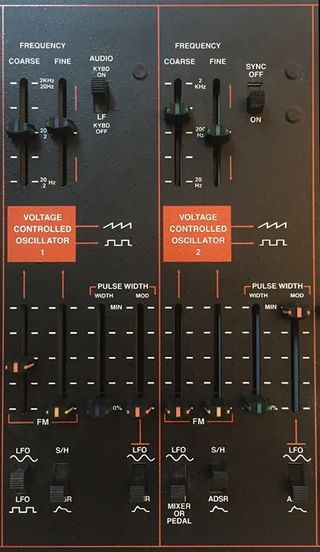
Pulse-Width Modulation
These modulation resources also allow for LFO-based pulse-width modulation to be applied independently to each oscillator, so you can use the sine wave to modulate the pulse-width of oscillator 1 while using a sawtooth on oscillator 2 (perhaps with a touch of the above-mentioned pitch modulation) for a really thick sound.

The 18 best synthesizers 2020: keyboards, modules and semi-modular synths
Another approach is to modulate the pulse-width of one or both oscillators via the Odyssey’s ADSR envelope. This adds a timbral sweep with a lot of harmonic character. Here are some rules of thumb for this type of envelope modulation:
Medium to long decays combined with a lot of modulation depth offers the most pronounced effect, which is great for sweeping leads and drones.
Increasing the attack slightly with a short decay gives the attack of each note a brass-like effect, especially when combined with a bit of pitch modulation on the other oscillator.
Setting all envelope parameters to their minimum (with maybe a tiny bit of increased decay) is great for adding a click-like transient to the attacks of notes.
Hard sync
The Odyssey was arguably the first mainstream synth to offer hard sync on its oscillators and is enhanced greatly by their range of modulation options. In a nutshell, hard sync causes oscillator 2 to reset its waveform every time oscillator 1 completes a cycle. Classic examples of this sound can be found in the main leads for “Let’s Go” by The Cars or “Atomic Dog” by George Clinton. It was also a key component in many of Billy Currie’s leads for the ’80s UK band Ultravox.
To create this effect on the Odyssey, turn Sync “on” for oscillator 2, then move its coarse pitch slider. You should immediately hear a flanger-like harmonic effect in oscillator 2’s spectrum.
While merely changing the tuning can be a great resource for new textures, the hard sync effect really comes to life when it’s modulated. Here are some tips for modulating oscillator 2’s pitch when sync is active.
1. Using the ADSR envelope is the secret for re-creating The Cars’ lead (which incidentally, was originally done on a Prophet-5). Increasing the attack slightly adds the squawk from “Atomic Dog.”
2. Low-rate sine-wave LFO modulation is cool for slowly evolving timbral sweeps.
3. Applying extreme Sample & Hold modulation—especially when combined with keyboard triggering (described in the next section)—is a dramatic effect that randomly changes the harmonic content of each note event.
4. Another unusual approach relies on using the Odyssey’s duophonic capability to actually play the sync. To begin experimenting with this technique, turn on sync, hold a note with your left hand, then play an arpeggio with your right. Because oscillator 2 has high-note priority, whatever is played with your right hand will appear as a harmonic “melody” applied to the drone note.
Modulation
Oscillator 1 has some cool tricks up its sleeve too, as it can also be used as an LFO when the aptly named “LF” switch is active. The Odyssey’s modulation section includes a sample-and-hold mixer, LFO, and lag generator that can be combined in several unique ways.
Sample-and-hold explained
On most modern synths this classic LFO effect is simply labeled “random,” but sample-and-hold is useful for much more than just random stepping. The way it works is quite simple: A source waveform—often white or pink noise—is captured in “snapshots” by a sample-and-hold generator, then the resulting value (or voltage) is used to modulate a given parameter.
The Odyssey’s S/H generator captures these voltage “snapshots” via either the LFO rate (for the classic “random waveform” effect) or, more interestingly, via the keyboard trigger, so that each note samples and holds (a-ha!) the voltage captured from the source. Adding to the complexity, different input sources create different effects.
Here’s a handy reference for the Odyssey’s S/H mixer inputs, which are used as the voltage source for the sample-and-hold generator.
1. Sawtooth (osc 1): Set to LF mode, applying osc 1’s sawtooth will create a rising, stepped effect. In normal pitch mode (LF off ) the effect will have a more random sound.
2. Pulse (osc 1): Set to LF mode, osc 1’s square/pulse will create an alternating effect as the voltage changes between the “up” and “down” state., but in conjunction with the S/H generator’s LFO, it’s more complex than standard square wave modulation. As with the sawtooth, turning osc 1’s LF mode off will generate a semi-random sound.
3. Noise generator: This creates the classic “random” effect that we’re familiar with on other synths.
Key Trigger vs LFO Trigger
Understanding this switch is essential for creating rhythmic effects with the S/H generator. In LFO Trig mode, the LFO determines the rate of the stepping. Since the Odyssey’s LFO can’t be synced to tempo, the results are useful for old-timey computer sound effects and other textures that don’t require synchronization. In Kybd Trig mode, each key event captures the voltage, so if you feed the Odyssey a sequence via MIDI (or use the trigger input jack) each new note will change the output voltage.
Pro Tip: Applying keyboard-triggered S/H modulation to the filter cutoff with a touch of resonance is a great way to emulate early-’ 80s Depeche Mode riffs.
Output Lag. More commonly found on modular gear, a lag generator slows the rate of voltage shifts, thus changing the output of the S/H generator from stepped to smooth. Lag generators are used to create portamento on real analog synths, by smoothing the voltage transitions between keys.
Pro Tip: Increasing the amount of Output Lag when creating a random effect via noise is the secret to replicating R2D2’s electronic “voice” (see Figure 2).

S/H mixer
While the S/H Mixer is the input source for the sample-and-hold generator, if you look closely at the filter and osc 2 modulation sections, you’ll see that “S/H Mixer” is one of the source options. With this mixer, you can combine the voltage outputs from osc 1 (in either LF or audio mode) with the noise generator or osc 2’s square and use that blended voltage as a modulation source for the filter and/or oscillator 2. Since the oscillators can be used in the audio range, this is a fantastic resource for nasty, aggressive textures. Here are some options for further exploration.
1. Noise: Setting the second slider to noise and raising it to maximum (while leaving the first slider at zero) is the method for applying noise modulation to osc 2 or the filter cutoff. It’s great for pseudo-distortion effects, but be forewarned: A little goes a long way.
2. VCO 1 (LF): Although the LFO is sine or square wave only, you can get sawtooth or variable pulse modulation from osc 1 when it’s set to low-frequency mode via the mixer.
3. VCO 1 or 2 (audio rate): Both oscillators can be combined and used as sources for filter FM effects. Because everything is analog, this won’t sound anything like software-based FM synthesis. Instead, the results will be extremely harsh, but great for industrial and techno effects.
Filter
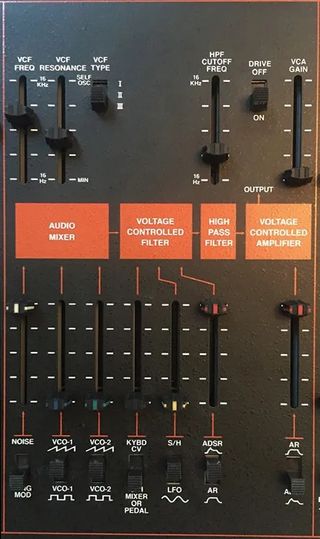
The Odyssey filter design is extremely straightforward, with audio mixing and modulation sources clearly laid out and highpass included for added color. What’s more, with Korg’s reissue, you can switch between the various lowpass circuits that were used in each of the three revisions that were released during its original run—including the Moog-like circuit used in Rev 2.
The Odyssey’s filter mixer section is where its Ring Modulator resides, on a fader that serves double-duty as the source for mixing white or pink noise into your audio signal (see Figure 3). While ring mod is generally used for radical, inharmonic tones, there’s a secret for getting really musical results from the Odyssey’s unit: Tune the oscillators’ intervals to either an octave or a fifth, then lower the volume of osc 1 and 2 in the filter mixer and raise the Ring Mod to maximum. From there, use the oscillators’ fine-tuning parameter until the ring mod effect “locks in,” creating a new harmonic resource. At that point, you can decide whether to add the oscillators back into the filter mix for added flavour.
Envelopes
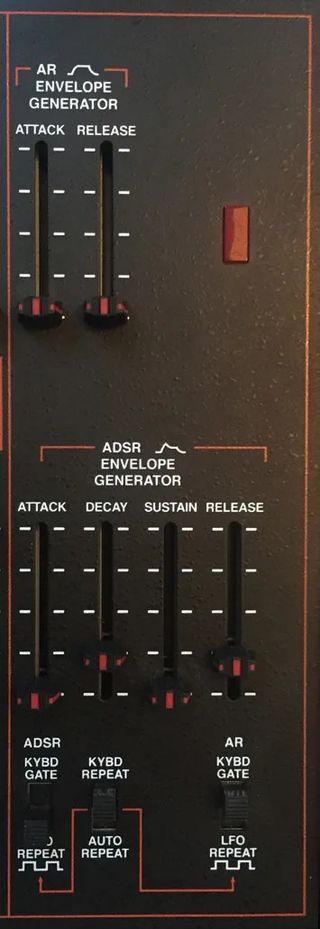
It’s important to keep in mind that the Odyssey’s attack-release and ADSR envelopes can be swapped between the filter and amp—or assigned to a variety of other destinations, like oscillator pitch and pulse width as described previously (see Figure 4). Here are some areas for further sonic exploration:
Modulate the pitch of osc 1, while it’s used in conjunction with ring modulation or as a low-frequency oscillator in the S/H mixer.
Assign the AR envelope to both filter and amplifier, then use it to create swells, while you assign the ADSR to other destinations.
Set the attack and release of the AR envelope to zero and use it like a gate envelope, while the ADSR modulates filter cutoff.
Pro Tip: Both of the envelopes also include the ability to repeat rhythmically when triggered by either the LFO or an external trigger input. If you want to “latch” the retriggering, so that you can take your hand off the keyboard and comp or solo on another, toggle the envelope settings to Auto Repeat.
The back panel
Finally, the Odyssey’s back panel has a few of its own surprises that are worth exploring.
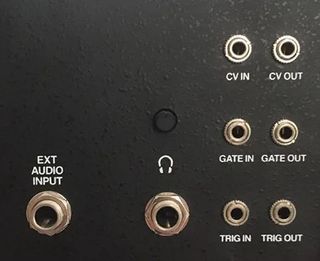
1. Monophonic mode: You can switch off the Odyssey’s duophonic behaviour by simply connecting an 1/8-inch mono cable from the back panel’s CV out to its CV in (see Figure 5). A Eurorack modular cable or MS20 Mini cable will do the trick.
2. External Input: You can run another synth, guitar, or even an effects insert into the Odyssey’s filter and VCA by plugging it into the external input. This is a great resource for processing old toys and other noisemakers you may have lying around the house. For extra credit, sequence the Odyssey to create rhythmic, gating effects with these sources.
If the price of hardware is too steep, there’s an app for that. Korg’s Odyssei for iOS does an excellent job of recapturing the vibe of the original, with the addition of integrated effects. It also includes a step-sequencer for expanded modulation resources.
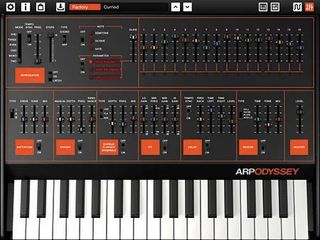
3. Trig In: The trigger input on the back of the Odyssey is compatible with Korg’s volcas, so if you want to sync the envelope’s Auto Repeat to your volca beats, this jack is the ticket.
So there you have it. Whichever Odyssey you own, a treasure chest of rich and complex textures awaits. It’s just a matter of understanding the programming nuances of this legendary beast.
Producer Francis Prève has been designing synthesizer presets professionally since 2000. You can check out his new soundware company at symplesound.com.


